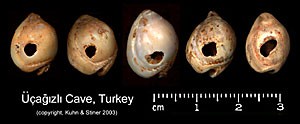Thousands of years before the signing of the Declaration of Independence, a much more important revolution took place, say two UA anthropology professors.
This revolution in human behavior, which had women at its center, may have been the death knell for Neanderthals, according to husband-and-wife team Steven Kuhn and Mary Stiner, whose article “”What’s a Mother to Do?”” in the December issue of Current Anthropology argues that men and women took on many of the same roles more than 50,000 years ago.
Prior to that time, most early cultures relied on big-game animals for food and had limited technology with which to hunt, Stiner said.
This meant a social structure of small family groups scattered across large areas, roving with their food sources – such as half-ton wild cattle and prehistoric deer – and requiring every member of the group to take part in hunting.
But the archaeological evidence points to a change about 50,000 years ago, Stiner said.
“”We’ve noticed, based on many years of research in the Mediterranean area, that there had been some pretty significant changes in diet,”” Stiner said, adding that these shifts in diet toward smaller-game animals necessitated a change in how people obtained and prepared food. This is also the time period that contains the first evidence of art and small tools for skill-intensive activities like sewing.
“”We wondered if there was a connection there, in how cooperative labor is and how it’s divided among individuals,”” Stiner said.
After studying the archaeological record and other literature in the field, Kuhn and Stiner hypothesized that the change in food sources was part of a broad cultural shift that included increasingly different roles for prehistoric men and women.
But Stiner stressed that their work doesn’t claim a lack of distinct gender roles in Neanderthal culture, saying it only points to less complicated, more similar ones.
“”It seems that in the middle Paleolithic, in the time of the Neanderthals, that women and men’s camps and women and men’s land use was basically unified,”” Stiner said. “”They may have differently allocated tasks, but it’s all within this scheme of them all staying together and moving basically in response to their need for large game animals.””
Kuhn and Stiner said in their article that because of this narrow focus on large-game hunting, Neanderthal women and children were not able to fill the more diverse roles they played in more recent hunter-gatherer societies. Women likely were part of the hunting activities, though probably by making noise or otherwise herding their targets into the clutches of the men.
The idea that Neanderthal women took part in hunts has spurred an intense amount of conversation, landing the pair’s hypothesis in The New York Times and several Web-based anthropology forums.
Stiner said the cultural revolution that took place 50,000 years ago created a more stable environment for finding food and raising families, resulting in population growth among humans in Africa. She said an increasing population could have been the main factor in pushing the human population out of Africa and into direct ecological competition with the Neanderthals, helping to cause their extinction.
Response to the article has been huge, Stiner said, with about half of the professional anthropologists she’s encountered supporting the couple’s view of Neanderthal society and the other half more critical.
Other, older theories held that Neanderthal men and women lived separately, coming together only to mate, or that Neanderthal women existed only as vessels for childbirth, Stiner said.
Stiner said she doesn’t believe either of the hypotheses, both of which she said are more radical than the majority of the criticism directed at her and her husband’s work.
For instance, some critics say that, while Stiner and Kuhn may be correct in their hypothesis about changing gender roles, they may have the time frame wrong. Stiner said some professional anthropologists have pointed to 30,000 years ago as a more likely time that this change may have happened.
While there may be more physical evidence from more recent times, Stiner said she still believes there is enough to suggest the cultural shift happened some 20,000 years earlier.
Still others, such as Stanford anthropologist Richard Klein, argue that a physical change in brain structure, allowing for things like language, that propelled modern humans past their Neanderthal cousins.
Despite some professional disagreement, Stiner said public reaction to the hypothesis has been mostly positive.
“”People are just really keen to know more,”” Stiner said.









